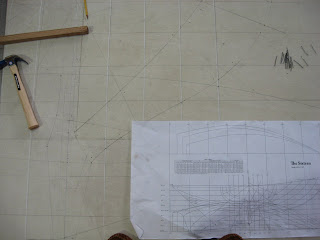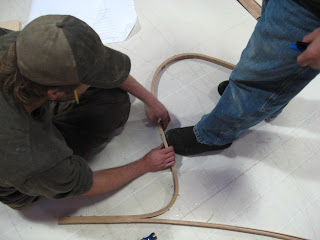Apparently my theory was correct. If you really want to learn about all things boaty, you have to go hang out where boats live.
on Saturday, I helped Cap'n Wayne-o and gang loft two sails for this ship at the Rec Center in Port Townsend. See the jib sail out front on the bowsprit where the black speck is standing? in the photo above? (Yep, that's a person.) We laid out and cut the inner and outer jib. The two sails laid out took up the whole basket ball court. I was supposed to be picking up redlines, but i figured an opportunity like this was too much to pass up.
cipher'n and Ponder'n
Cap'n Wayne'o explained the current state of sail making affairs to me, and it was very enlightening. Most sails are computer generated and cut on the fabric industry equivalent of a CNC machine. They are then shipped to a sail maker who stitches them together, makes all the tabling and patches,(reinforcement at the edges and corners,)and then completes all the hand work like boltropes, grommets, slides, etc. Unfortunately, when owners of traditional boats buy new sails, they try to optimize performance through purchasing new CNC sails made of high tech fabrics with modern panel layouts. They often fail to realize that the boat and the rig are two components of the same system, and that if the hull shape is not optimized as well, the gains in rig efficiency are lost in the total equation. Why put a Porsche engine in a chevy astro? It ain't gonna work. Now they have a classic B.B. Crowninshield stay'sl schooner with one crunchy new Dacron radial cut main, and a traditionally cut fore'sl. It looks stupid, and might go a negligible bit faster.
Chalk line layout
The sails are marked on the floor with a standard carpenter's chalk line and chalkboard chalk.
Cap'n Wayne-o rolls out and tapes down the first panel. He is preparing to mark the curve in the leech of the sail. (The aft trailing edge). We used a 100' tape stretched out an then carefully tugged it into position to get the curve. We then sighted down the curve to fair it, much like in lofting a boat. In a traditional sail loft, the fabric would be pinned to the floor, but here we had to use tape. Duct tape, no less. I felt perfectly at home.
This is as far as i got. I gave myself until noon, and then i went back to the Hole to finish my drawings. They will lay out all the sails, mark where they all match at the seams, (much like the little notches you see in clothing patterns,) fold the panels carefully in a specific order, and then take them to the sail loft at the commune to stitch. Strangely enough, they will never see it laid out again until it is flying on the Tole Mour.
I'll have to go to California some day and see how my first professional sail turned out. Pretty big step up from my bed sheet sail i cut for the Eel, my 7' dinghy. Turns out though, i actually had the concept right. I was pleased to discover this.
As you can see, i actually laid out and cut panels, (while Commander Wiggleberry walked all over my sail sniffing every seam). My leech curve is floppy, and my mast is, yet again, too stubby, but I'm pretty sure my biggest mistake was not holding out for Star Wars sheets from Goodwill.




































